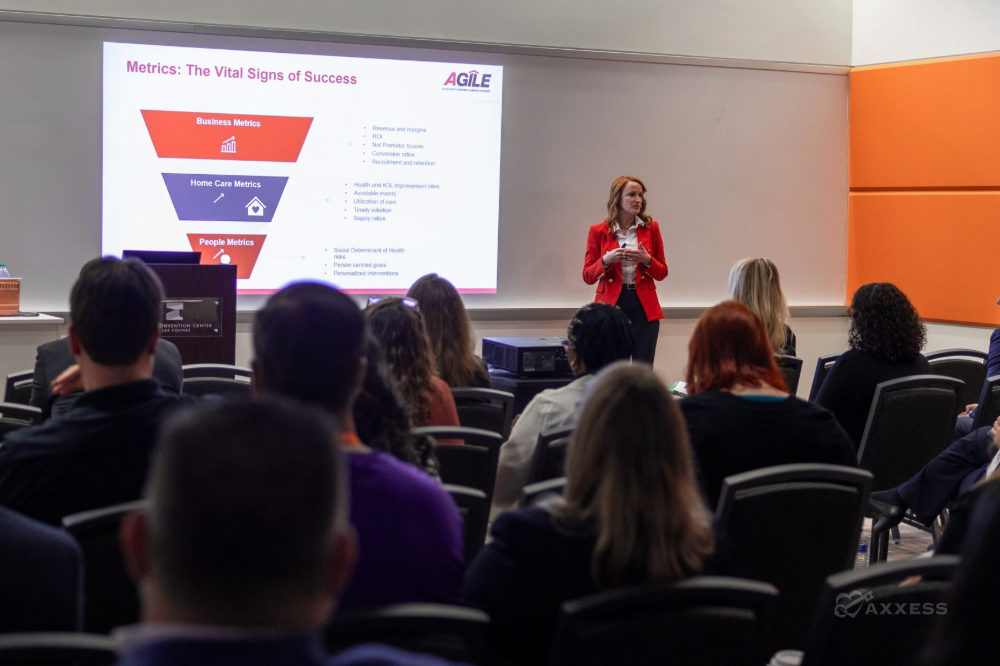
The use of artificial intelligence (AI) continues to be a topic of discussion in the care at home industry. While the functionality of AI is constantly evolving and improving, a pair of industry leaders shared the ways AI can be leveraged by home care leaders at the 2024 Axxess, Growth, Innovation and Leadership Experience (AGILE).
Sara Wilson, President and CEO of Home Health Assist, and Guy Tommasi, President and CEO of the Corcoran Consulting Group, discussed the changing care at home landscape and how leveraging tools like AI can help organizations navigate industry challenges.
The Changing Landscape
Tommasi opened the session with a discussion on the evolving home care landscape and echoed earlier sentiments from the conference, noting that outside industries want to be involved in the home care business. Tommasi highlighted that these businesses take chances in home care when often organizations within the industry do not.
“Who would have thought five years ago Walgreens would be in our space, Amazon would be in our space, Dollar General would be in our space, Best Buy in our space?” Tommasi asked. “They see what maybe some of us have not seen: opportunity. There’s opportunity to generate great revenue, good revenue in our business and industry.”
Tommasi also addressed value-based care, driving home the message that home care is the future of the value-based model and organizations need to prepare themselves for the changes and challenges that brings.
“Over $260 billion in chronic care is going to be in the home within the next five years,” Tommasi said.
“Are you ready to compete in an extremely competitive market?” Tommasi asked. “Do you have the automation, the innovation to compete?”
Tommasi ended his portion outlining the importance of metrics, noting that organizations need to seek out tools that help better relay data on items like rehospitalizations and client satisfaction. For leaders who are looking to expand or partner with other businesses, paying more attention to what and how data is collected will better prepare them for partnership.
“If we want to be part of the bigger picture with the stakeholders, there has to be a willingness to go with the extra mile, to go outside of our comfort zone, to start to look at what we need to have,” Tommasi said.
The Use of AI in Home Care
While acknowledging the need for organizations to look at metrics and data, Wilson also acknowledged the current limitations and challenges within the industry and how the use of AI can solve for some of those challenges.
Wilson stated that she looks at AI as three-fold, broken up into artificial intelligence, authentic intelligence and augmented intelligence. While each serves a purpose, special attention was paid to augmented intelligence.
“This is when you take AI to augment and enhance the person,” Wilson said.
She emphasized that AI is only as good as the systems and processes that support it. If staff are not taught how to properly use it or do not have a system for use in place, the tool becomes meaningless.
“So, when I look at it this way, I fell in love with how we can use AI to not only help our employees work to the top of their profession, but for the people that we serve to live to the best of their choice,” Wilson said.
Wilson encouraged leaders to look at specific AI tools to address their needs or pain points, providing an example of how an AI tool focused on dementia care can take the historical data and areas of difficulty for the patient and then provide the caregiver or family with specific interventions to try.
Wilson explained that when organizations look at AI, they need to keep in mind that it should be used to unlock human potential, to free up time from repetitive and mundane tasks, so that time and energy can be spent on caring for patients.
She concluded the session by reiterating that AI should be working for the organization and that leaders should have a clear understanding of what they are trying to accomplish to see success.
“We need to identify the solution [and] measure that partner’s performance and ability to meet those goals for us,” Wilson said. “We can come up with all these really great ideas, but if we’re not matching it with a system and a process protocol, operating systems, tools, our team’s just going to be left confused and not knowing how to use it.”
With more than 350 attendees, more than 50 sponsors and countless connections made, AGILE 2024 was a massive success for everyone. Check out this recap video.
